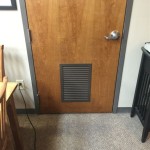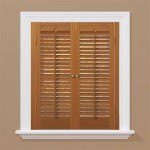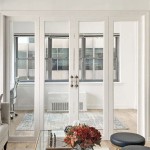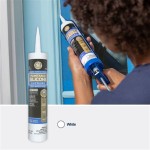Interior Hollow Core Prehung Doors: A Comprehensive Guide
Interior hollow core prehung doors represent a prevalent and cost-effective solution for interior door installations in residential and commercial spaces. This comprehensive guide delves into the intricacies of these doors, encompassing their construction, advantages, disadvantages, installation considerations, and maintenance.
Hollow core doors, as the name suggests, are characterized by their hollow interior. This construction method significantly reduces the door's weight, making it easier to handle and install. The exterior of the door typically consists of a thin wood veneer or composite skin, supported by an internal honeycomb or grid-like structure made of cardboard or plastic. This internal structure provides minimal support beyond maintaining the door's shape.
Prehung doors, in contrast to door slabs, come already mounted within a door frame. This frame includes the side jambs, head jamb, and doorstop, providing a complete unit ready for installation into a prepared doorway. The door is typically pre-mortised for hinges and a lockset, streamlining the installation process.
Advantages of Interior Hollow Core Prehung Doors
Hollow core prehung doors offer several advantages, making them a popular choice for many construction and renovation projects. These advantages pertain to cost, ease of installation, and aesthetic versatility.
Cost-Effectiveness: Hollow core doors are significantly less expensive than solid core or solid wood doors. The lower cost stems from the use of less material and a simpler manufacturing process. This makes them an attractive option for budget-conscious projects, especially when multiple doors are required.
Ease of Installation: Prehung doors simplify the installation process considerably. Because the door is already mounted within its frame, with hinges pre-installed, the installer only needs to secure the frame within the doorway. This reduces the time and effort required for installation compared to installing a door slab, which involves mortising for hinges and ensuring proper alignment within an existing frame.
Lightweight Construction: The hollow core construction makes these doors significantly lighter than solid core or solid wood doors. This lighter weight makes them easier to handle, transport, and install, particularly for single-person installations. It also reduces stress on the door frame and hinges over time.
Aesthetic Versatility: Hollow core doors are available in a wide range of styles and finishes, including various wood veneers, primed surfaces ready for painting, and molded panel designs. This versatility allows them to complement a variety of interior design schemes. The smooth, paintable surface makes it easy to customize the door's appearance to match the room's decor.
Disadvantages of Interior Hollow Core Prehung Doors
Despite their advantages, hollow core prehung doors also have several drawbacks that should be considered before making a purchase. These disadvantages relate primarily to durability, sound insulation, and security.
Limited Durability: Due to their hollow core construction, these doors are less durable than solid core or solid wood doors. They are more susceptible to dents, dings, and punctures from impacts. The thin veneer or composite skin can be easily damaged, and repairing such damage can be challenging.
Poor Sound Insulation: The hollow interior of these doors provides minimal sound insulation. Sound travels easily through the door, making them unsuitable for rooms where noise reduction is a priority, such as bedrooms, home offices, or media rooms. Solid core or solid wood doors offer significantly better sound dampening capabilities.
Reduced Security: Hollow core doors offer less security than solid core or solid wood doors. They are easier to break through, making them a less secure option for exterior doors or interior doors where security is a concern. The thin veneer and hollow interior provide little resistance to forced entry.
Limited Fire Resistance: Hollow core doors offer minimal fire resistance. They can burn through quickly in the event of a fire, providing little protection against the spread of flames and smoke. Fire-rated doors, which are specifically designed to resist fire for a certain period, are required in certain building codes, particularly for doors leading to garages or between living spaces and mechanical rooms.
Installation Considerations for Interior Hollow Core Prehung Doors
Proper installation is crucial for the performance and longevity of any door, including interior hollow core prehung doors. Careful attention to detail during the installation process will ensure a smooth operation, a secure fit, and a professionally finished appearance.
Accurate Measurements: Before purchasing a prehung door, it is essential to accurately measure the existing doorway opening. Measure the width and height of the opening at several points to ensure it is square and consistent. The door frame should fit snugly within the opening, with minimal gaps around the perimeter. A slightly larger opening can be shimmed, but an opening that is too small will require modification, which can be time-consuming and costly.
Proper Framing: The existing doorway framing must be square, plumb, and level. Any irregularities in the framing can cause the door to bind, not close properly, or appear crooked. Use a level and a square to check the framing before installing the door. Correct any imperfections by shimming or adjusting the framing as needed.
Shimming and Securing: After placing the prehung door unit into the doorway opening, use shims to ensure that the frame is plumb and level. Place shims behind the hinges, strike plate, and at various points along the jambs to provide solid support and prevent the frame from warping or twisting. Secure the frame to the wall studs using screws long enough to penetrate the studs. Avoid over-tightening the screws, which can distort the frame.
Door Alignment: Check the door's alignment within the frame. The door should swing freely without rubbing against the jambs or the floor. Adjust the hinges or shims as needed to achieve proper alignment. Ensure that the latch engages smoothly with the strike plate. If necessary, adjust the strike plate to ensure a secure latch.
Maintenance of Interior Hollow Core Prehung Doors
While hollow core doors require less maintenance than solid wood doors, regular care can help prolong their lifespan and maintain their appearance. Simple cleaning and occasional repairs can prevent minor issues from escalating into major problems.
Regular Cleaning: Clean the door surfaces regularly with a mild detergent and water. Avoid using harsh chemicals or abrasive cleaners, which can damage the finish. Wipe the door dry after cleaning to prevent water spots or stains. Pay particular attention to areas that are frequently touched, such as the door handle and edges.
Hardware Maintenance: Periodically check the door hardware, including the hinges, doorknob, and lockset. Tighten any loose screws and lubricate the moving parts with a silicone-based lubricant. Replace any damaged or worn-out hardware to ensure smooth operation and security.
Repairing Minor Damage: Small dents and dings can be repaired with wood filler or spackle. Apply the filler to the damaged area, allow it to dry completely, and then sand it smooth. Prime and paint the repaired area to match the rest of the door. For larger damages, it may be necessary to replace the entire door skin or even the entire door.
Avoiding Moisture Exposure: Hollow core doors are susceptible to damage from moisture. Avoid exposing them to excessive humidity or water. Ensure that the door frame is properly sealed to prevent water from seeping in. If the door is located in a high-humidity area, consider using a moisture-resistant paint or sealant.
By understanding the advantages, disadvantages, installation considerations, and maintenance requirements of interior hollow core prehung doors, homeowners and contractors can make informed decisions about their suitability for various applications. This understanding can lead to successful installations, enhanced aesthetics, and prolonged door lifespan.

Prehung Doors Important Tips More Blog

Masonite 30 In X 80 2 Panel Arch Top Right Handed Hollow Core Textured Primed Composite Single Prehung Interior Door 17996 The Home Depot

Masonite 28 In X 80 2 Panel Square Top Right Handed Hollow Core Smooth Primed Composite Single Prehung Interior Door 18078 The Home Depot

Masonite 36 In X 80 Lincoln Park 1 Panel Right Handed Hollow Core Primed Composite Single Prehung Interior Door 82970 The Home Depot

Masonite Traditional 32 In X 80 6 Panel Hollow Core Molded Composite Left Hand Single Prehung Interior Door The Doors Department At Com

2 Panel Cambridge Hollow Core Prehung Interior Moulded Door China Wood Made In Com

Troubleshooting A Prehung Door Installation Fine Homebuilding

Flush Doors A Comprehensive Guide Oppolia

Setting Prehung Doors Fine Homebuilding

Reliabilt 32 In X 80 Steel Right Hand Inswing Primed Unfinished Prehung Slab Door Single Front With Brickmould Insulating Core The Doors Department At Com
Related Posts








